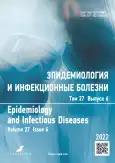The case of food botulism F
- Authors: Nikolaeva I.V.1, Gilmullina F.S.1, Kazancev A.Y.2, Fatkullin B.S.2
-
Affiliations:
- Kazan State Medical University
- Republican Clinical Hospital of Infectious Diseases named after A.F. Agafonov
- Issue: Vol 27, No 6 (2022)
- Pages: 360-367
- Section: CASE REPORTS
- URL: https://journals.rcsi.science/1560-9529/article/view/126022
- DOI: https://doi.org/10.17816/EID120021
- ID: 126022
Cite item
Abstract
This case describes a rare case of food botulism F in a 42-year-old man, which developed after he ate dried fish. The disease proceeded in a severe form with the development of ophthalmoplegia, tetraparesis, and respiratory failure. Monovalent antitoxic serums against botulinum toxins A, B, and E were administered to the patient. However, on the third day of the disease, he developed fulminant toxic myocarditis with asystole. Despite successful resuscitation, the patient developed a post-resuscitation disease and anoxic encephalopathy. The disease was complicated by severe aspiration pneumonia caused by Klebsiella pneumoniae (ESBL+). The duration of mechanical ventilation was 12 days. His hemodynamics stabilized on the eighth day of illness, and on the 19th day of illness, physical activity and a state of minimal consciousness appeared. The patient was transferred to the rehabilitation department on the 22nd day of the illness.
Doctors should be informed about the possibility of the development and severity of botulism caused by botulinum toxin type F. It is necessary to introduce polyvalent antibotulinic serum into clinical practice, including antitoxins against rare types of botulinum toxin.
Keywords
Full Text
##article.viewOnOriginalSite##About the authors
Irina V. Nikolaeva
Kazan State Medical University
Author for correspondence.
Email: irinanicolaeva@mail.ru
ORCID iD: 0000-0003-0104-5895
SPIN-code: 4103-5663
MD, Dr Sci. (Med.), Professor
Russian Federation, KazanFayruza S. Gilmullina
Kazan State Medical University
Email: fayruza.gilmullina@yandex.ru
ORCID iD: 0000-0002-3015-8920
SPIN-code: 8620-0710
MD, Cand. Sci. (Med.), Associate Professor
Russian Federation, KazanAleksander Yu. Kazancev
Republican Clinical Hospital of Infectious Diseases named after A.F. Agafonov
Email: engine90@bk.ru
ORCID iD: 0000-0001-9800-9940
SPIN-code: 4888-8556
MD, Cand. Sci. (Med.)
Russian Federation, KazanBulat Sh. Fatkullin
Republican Clinical Hospital of Infectious Diseases named after A.F. Agafonov
Email: bulat.fatkullin.68@bk.ru
SPIN-code: 8772-3423
MD, Cand. Sci. (Med.)
Russian Federation, KazanReferences
- Nikiforov VV, Tomilin YuN, Davydov AV, et al. The case of severe botulism: artificial ventilation of lungs for 127 days. Epidemiology and Infectious Diseases. 2013;18(6):49–57. (In Russ). doi: 10.17816/EID40793
- Rao AK, Sobel J, Chatham-Stephens K, Luquez C. Clinical Guidelines for Diagnosis and Treatment of Botulism, 2021. MMWR Recomm Rep. 2021;70(2):1–30. doi: 10.15585/mmwr.rr7002a1
- Smith TJ, Hill KK, Raphael BH. Historical and current perspectives on Clostridium botulinum diversity. Res Microbiol. 2015;166(4):290–302. doi: 10.1016/j.resmic.2014.09.007
- Mazuet C, Legeay C, Sautereau J, et al. Characterization of Clostridium Baratii Type F Strains Responsible for an Outbreak of Botulism Linked to Beef Meat Consumption in France. PLoS Curr. 2017;9.
- Hall JD, McCroskey LM, Pincomb BJ, Hatheway CL. Isolation of an organism resembling Clostridium barati which produces type F botulinal toxin from an infant with botulism. J Clin Microbiol. 1985;21(4):654–655. doi: 10.1128/jcm.21.4.654-655.1985
- Sobel J, Dill T, Kirkpatrick CL, et al. Clinical recovery and circulating botulinum toxin type F in adult patient. Emerg Infect Dis. 2009;15(6):969–971. doi: 10.3201/eid1506.070571
- Gupta A, Sumner CJ, Castor M, Maslanka S, Sobel J. Adult botulism type F in the United States, 1981–2002. Neurology. 2005;65(11):1694–1700. doi: 10.1212/01.wnl.0000187127.92446.4c
- Moodley A, Quinlisk P, Garvey A, et al.; Centers for Disease Control and Prevention (CDC). Notes from the field: infant botulism caused by Clostridium baratii type F — Iowa, 2013. MMWR Morb Mortal Wkly Rep. 2015;64(14):400.
- Tréhard H, Poujol I, Mazuet C, et al. A cluster of three cases of botulism due to Clostridium baratii type F, France, August 2015. Euro Surveill. 2016;21(4). doi: 10.2807/1560-7917.ES.2016.21.4.30117
- Yu PA, Lin NH, Mahon BE, et al. Safety and Improved Clinical Outcomes in Patients Treated With New Equine-Derived Heptavalent Botulinum Antitoxin. Clin Infect Dis. 2017;66(Suppl. 1):S57–S64. doi: 10.1093/cid/cix816
Supplementary files







